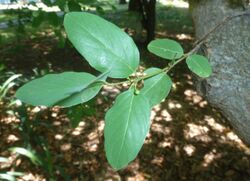Biology:Pink ivory
| Pink ivory | |
|---|---|

| |
| Scientific classification | |
| Kingdom: | Plantae |
| Clade: | Tracheophytes |
| Clade: | Angiosperms |
| Clade: | Eudicots |
| Clade: | Rosids |
| Order: | Rosales |
| Family: | Rhamnaceae |
| Genus: | Phyllogeiton |
| Species: | P. zeyheri
|
| Binomial name | |
| Phyllogeiton zeyheri (Sond.) Suess.
| |
| Synonyms[1] | |
| |
Pink ivory (Phyllogeiton zeyheri, syn. Berchemia zeyheri), also called purple ivory, red ivory, umnini or umgoloti, is an African hardwood used to make a variety of products (for example: billiard cues and knife handles).[2] The pink ivory tree grows predominantly in Zimbabwe, Mozambique, Northern Botswana and South Africa .[1] The tree is protected and sustainably maintained in South Africa, only felled by very limited permit.[3][4] The wood is extremely hard, with a density of 990 g/dm3.
Pink ivory was the royal tree of the Zulu people[5] and only members of the royal family were allowed to possess it until the Anglo-Zulu War of 1879. Before the Anglo-Zulu War, the Zulu king (and prior to 1818, Zulu chiefs) would possess a pink ivory knob kerry, a stick with one end a knob, and wear jewelry that were also made from pink ivory. According to rumor, non-royals who possessed the wood would summarily be put to death. After Zululand fell to the British and was separated into 13 separate "kinglets" in 1883, all vying to retake control of what was once theirs precedent to the onset of apartheid, the pink ivory wood became much less important a sign of control than genuine control could be.
The pink ivory tree produces a yellow, brownish, reddish, or purplish drupe fruit that is delicious to taste. Other parts of the tree have been used traditionally as remedies and medicines.
Pink ivory is often cited as one of the most expensive woods in the world, along with African blackwood, sandalwood, agarwood and ebony.[6][7]
References
- ↑ 1.0 1.1 "Phyllogeiton zeyheri (Sond.) Suess." (in en). Royal Botanic Gardens, Kew. http://www.plantsoftheworldonline.org/taxon/717972-1.
- ↑ "Berchemia zeyheri | PlantZAfrica.com". http://www.plantzafrica.com/plantab/berchemzey.htm.
- ↑ "Archived copy". http://www.daff.gov.za/doaDev/sideMenu/ForestryWeb/dwaf/cmsdocs/Elsa/Docs/PT/Revision%20of%20National%20Protected%20Trees%20List%202002.pdf.
- ↑ Fisheries, Department of Agriculture, Forestry and. "Department of Agriculture, Forestry and Fisheries > Branches > Forestry & Natural Resources Management > Forestry Regulation & Oversight > Sustainable Forestry > Protected Trees" (in en-US). http://www.daff.gov.za/daffweb3/Branches/Forestry-Natural-Resources-Management/Forestry-Regulation-Oversight/Sustainable-Forestry/Protected-Trees.
- ↑ "Berchemia zeyheri | PlantZAfrica.com". http://www.plantzafrica.com/plantab/berchemzey.htm.
- ↑ "Top 10 Most Expensive Woods in the World". 18 November 2016. http://renesabino.com/luxury-blog/top-10-expensive-woods-world/.
- ↑ "11 Most Expensive Woods in the World". 22 July 2020. https://ventured.com/most-expensive-woods-in-the-world/.
Wikidata ☰ {{{from}}} entry
 |

